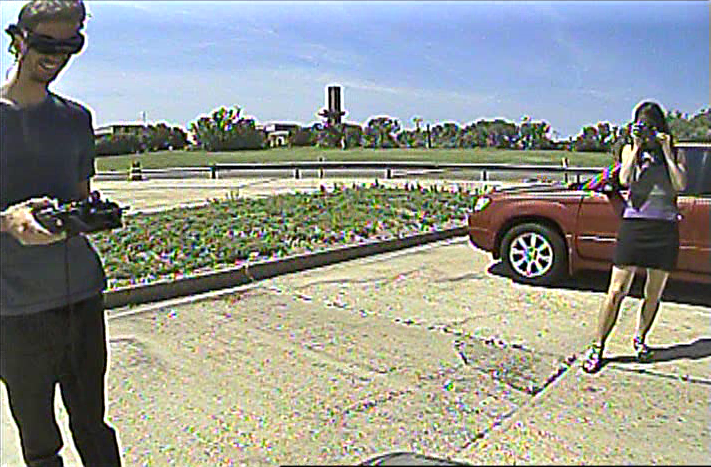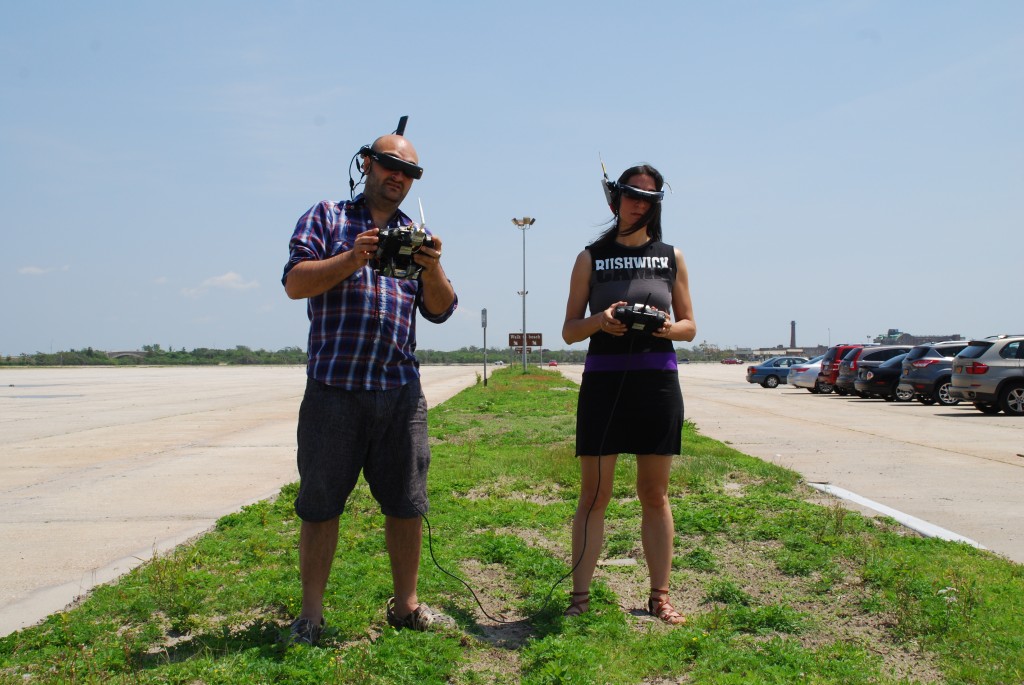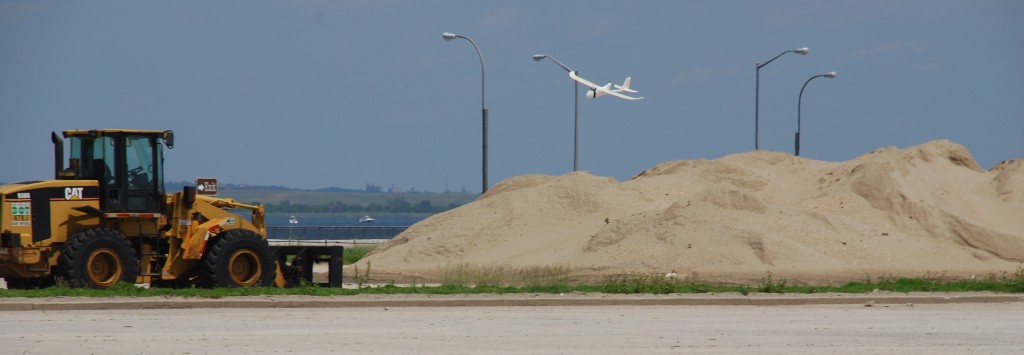By Arthur Holland Michel
“I do this because it is fun,” Georgi Tushev told me as he loaded a lipo battery into his drone. We were in an enormous oval-shaped parking lot in the Rockaways, a slender peninsula at the southern end of Long Island. I was watching Georgi as he tinkered with wires, propellers and antennae, both of us sizzling under the midday sun. Georgi’s wife, Nina, was sitting in the driver’s seat of their red Subaru, drinking water. When they picked me up from my house in Brooklyn that morning, she said, “Having a Subaru says something specific about you, I think, right?” The drone in question, which has a wingspan of about four feet, looks more like a glider than a Predator. Its single, rear-facing propeller emits a shrill buzz, somewhere between a hand drill and a dentist drill, though it was much quieter than I had expected. Georgi handed me a pair of virtual-reality goggles with a large antenna stuck to the back of the strap. When I put them on I saw what the drone saw. A small camera mounted on the aircraft’s nose was transmitting a live feed directly to my headset; at that moment, the view consisted mostly of Georgi’s hunting-camo Crocs. He gave me a standard remote control handset, which was connected to his set by a single black wire. This wire would allow us to take turns flying, like co-pilots in the cockpit of a large aircraft. Through the goggles, I saw that Georgi had picked up the drone. The whir of the engine filled the air. “Ok.” He powered the engine to full throttle and hurled the drone into the air, like a javelin. Immediately, the nose dipped, and I panicked, but Georgi quickly recovered and we began our ascent. “Oops,” he said, “the nose dipped a little there on the take-off.” The sound of the drone was rapidly fading into the distance. We had been flying for a grand total of about thirty seconds. I heard Georgi flick a switch on his remote. “OK,” he said, “you’re in control.”
Nina and Georgi Tushev have flown their drones all over the world, from a reservoir in their native Bulgaria to the active volcano on the island of Stromboli, off the coast of Sicily, to a meteor crater in Arizona. They try to make outings every week, “but in reality, it’s more like every two weeks,” explained Nina. Their system of choice, which is called FPV (it stands for First Person View, referring to the live feed video that permits you to fly the drone as though you are sitting inside it), is relatively rare in the world of hobbyists. Detractors of FPV say that it is easy to get disoriented, and that it is difficult operate; however, no other system brings you as close to the thrill of actually flying. Before our first flight, Nina picked up the drone while I was wearing the goggles, and pointed it at me, so that I was looking at myself in real time, from outside of myself. It was a very strange feeling, almost hallucinatory. “It is weird, right?” she said.

They had agreed to let me tag along with them on one of their outings. When Georgi told me, as we cruised along the Gowanus Expressway, that I would actually get to fly the drone myself, I was both extremely excited and extremely worried. I hardly knew the Tushevs; I did not want to crash their drone, or, worse, somehow get them arrested. Trying to sound casual, I mentioned the drone that had come within 200 feet of an Alitalia passenger plane on its descent into John F. Kennedy Airport, prompting widespread outcry. If the drone had collided with the airliner, there could have been a serious accident. “We will try not to do that,” said Georgi.
When we got out of the car, we looked up at the sky; by which I mean, we really paid attention to the sky. It was a clear day, and though it was only 10am, it was already hot. A few miles away, a large airliner was making its final descent into JFK. I could hear the faint murmur of a helicopter, but I couldn’t spot it. Soon after, a Cessna single-prop passed by as it traced the beach. Up in the outer edges of the troposphere, another airliner was casting an arrow-straight contrail against the pale blue firmament. I realized how drones introduce into our existence a new dimension of space. We hadn’t even pulled the drone out of the car and we were already concerned with the multi-layered traffic above us. I also realized that the sky—especially the sky over New York City—is a very busy place.
I wasn’t entirely sure if what we were doing was legal. Sure enough, after a few minutes of flying, an NYPD helicopter made a broad circle over the parking lot. Apparently, while Georgi and I were flying the second time, a police car had pulled up and the cop had watched us for a few minutes, before driving away without saying a word. Nina had, very wisely, decided against alerting Georgi and I while we were in mid flight.

After scanning the sky for a while, Georgi, a painter by training whose work has been shown in solo and group shows in the U.S. and Europe, began to explain the technology of the plane, which has the letters NT (Nina Tushev) printed on the wing. “It is really simple,” said Georgi. He started talking very quickly about radio frequencies, frequency boosters, polarity, magnetic fields, antennae, and throttle trimming. Later in the day, over lunch at an Uighur restaurant in Brighton Beach, Georgi explained how he got into FPVs. His father, a colonel in the Bulgarian army, was a rocket scientist—“in the non-proverbial sense,” said Nina—and so, growing up, he was always learning how to make things fly. As technology grew better, and it became possible to strap a camera to a remote-control plane, his interest deepened. There is a pleasing symmetry in the story of how Georgi came to become an RC hobbyist. He explained that he uses magnets in his art to create wild, three-dimensional paintings. “I rely on magnetic fields in my art,” he said. “Recently, I realized that I rely on the same tool, the magnetic fields, for flying.”
Back in the parking lot, while Georgi ran me through the purposes of the many black and red cables snaking throughout the plane and its controls, I was finding it difficult to keep up. I did, however, manage to recognize some of the ingenious features of Georgi’s design, such as the wireless booster that he had attached to his remote control in order to expand its range by orders of magnitude, or—my favorite—the camera on the plane, which he had attached to the rudder controls, allowing the pilot to turn the camera from side to side while flying. There was a great deal of glue and duct tape holding the system together; that said, it all worked beautifully. “My house is full of parts,” he explained, Nina nodding in agreement. Their drones are rather old-fashioned compared to the more complex, less do-it-yourself systems that are available, such as Ardupilot, which allows the drone to fly autonomously, or the fly-by-wire systems that process commands to the vehicle through a computer. Georgi explained that his method was more direct and pure, less boring. He said that “it is like the fixed-gear bicycle of drones.” Ultimately, it is more like actually flying. Which, it so happened, we were now ready to do.
That first flight was so incredible, so unfamiliar, so thrilling, that it was very difficult to articulate exactly how it felt, either at the time or in retrospect. When I was a kid, my father took me and my brother to a grassy airstrip to watch a group of RC hobbyists flying little, noisy gasoline airplanes in the wide Australian sky. I remember finding it boring, noisy, and smelly (this was true of both the planes and the hobbyists). The FPV flight was completely different. I was inside the plane, flying hundreds of feet over the Rockaways. If you have ever had a dream in which you can fly—the sensation of flight without the wind or the window framing your view—you will have some sense of what it is like. I felt like I needed to say something, so I just kept saying “Wow.” When Georgi let me take the controls, I expected the plane to go into a steep nosedive, but instead it was smooth, responsive. I giggled like a child, which, in a way, is how I felt. “Wow, that is just…”

Over lunch, I told Nina that I felt like I had been robbed of my eloquence. “That is a good way to put it,” said Nina, “you should write that in your article.”
We flew along the peninsula, almost to Breezy Point, a gated-community that had been devastated by a huge fire during Hurricane Sandy. Low-altitude flight—something that few of us actually experience except during those sweaty few minutes after take-off and before landing on a commercial flight—gives you an utterly new perspective on your environment. I usually find it a little hard to get my bearings in a new place, but once I got an eye up in the sky, and saw the whole length of the Rockaways, I understood my surrounding area better than if I had consulted map. The term “eye in the sky” started to make a lot more sense. “Of course police departments want drones,” I thought.
Nina informed us that we had already been flying for ten minutes. Since the battery only lasts for about twenty minutes, we had to turn around. At Georgi’s urging, I did a couple of barrel-rolls and a loop-the-loop (“Wow, that is just amazing”). Georgi spotted some birds, and for a while we chased them around the parking lot. Then he brought it in for a perfect landing, about ten feet from where we were standing.
In part, the experience was thrilling because it lets you experience a power that you have never experienced before. “It is an extension of yourself,” Nina explained, when we had lunch. As Georgi was unplugging all the cables, I blurted out, “imagine this in the wrong hands.”
“Imagine a brick in the wrong hands,” said Nina. “The technology is already there. We’re not going back.”
Nina and Georgi took a flight together while I watched the live feed through a small monitor. More and more people were arriving at the parking lot, and as they walked past us with their folding chairs and beach towels, they stared at the two Bulgarians wearing virtual reality goggles, holding RC handsets, speaking to each other in Bulgarian. The drone was already far off in the distance, out of sight and earshot, so for the passers-by it must have been anyone’s guess what the two eastern Europeans were actually doing. I tried to look as nonchalant as possible.
The Tushevs did not meet in Bulgaria. Nina moved to New York City with her parents and her brother when she was sixteen, shortly after the fall of the Berlin Wall. A full U.S. citizen now, she is tall, dark-skinned, quite striking to behold. Though she has retained a noticeable Bulgarian accent, she speaks confidently, and with eloquence. She works as a consultant in indigenous rights for the United Nations. Georgi, who left home when he was thirteen, moved to New York City in 2000 after receiving an MFA from the National Academy of Fine Arts, in Sofia. He is a little shorter than Nina, and when I first met him, he had a thick, black beard. “It’s probably better not to have the beard when I’m flying the drone,” he joked. Georgi met Nina through a mutual friend at cafe in the Williamsburg neighborhood of Brooklyn. In January, 2012, he proposed to her at the 42nd St subway stop on the 4-5-6 line, and six days later, they were married.The couple live in the Long Island City neighborhood of Queens, a short subway ride from the United Nation Headquarters.

After our final flight of the morning, Georgi told me that he didn’t used to call his planes drones, but that changed when he read Kill Decision by Daniel Suarez and realized that his kits were essentially no different from what Suarez describes as the original drones, small remote controlled planes that the military used for target practice in the Second World War. Nina still doesn’t call them drones, because of all “baggage,” as she puts it, that the word carries with it. “Although,” she said, “I guess a rose by any other name…”
Whether they like it or not, Nina and Georgi Tushev are participating in a very polemical debate (“we’re not hiding,” said Georgi). For many observers of drone-istas like the Tushevs, the mere act of flying a drone seems to be an endorsement. But Georgi’s artistic mission for the project is not to make a political claim; instead, as he put it, he just wants to show “what’s possible.” The project is about the pure fantasy of flight. “I understand that what we’re doing is controversial,” he explained, “but I like a bit of controversy. All art needs a bit of controversy.”
Tushevs Aerials is also a project of personal exploration. In spite of the attention that their work inevitably attracts, the Tushevs fly for themselves. There is a strong thirst for knowledge and experience running through their attitude. My own thirty or so minutes of flying time had definitely altered my feelings. The allure of flight is irresistible, and I wondered whether their experience of flying had made them more sympathetic to those who are in favor of drones.
It seems that, in part, it has. For Georgi, who, along with Nina, staunchly opposes the use of drones for killing, policing, and surveillance, home-made drones do not pose any more of a threat to privacy than camera-phones. The fact that it is now possible to take personal images from the air using a noisy, failure-prone vehicle that can’t remain aloft for more than fifteen minutes doesn’t change anything. I asked if there should be any regulation governing private or commercial drone use. “In my soul, by definition,” he said, “I’m an anarchist in a way, so I think like every inch of lost freedom is just tragedy.” He acknowledged that, like guns or cars, some drones are more powerful than others, and there does need to be some kind of system that regulates our access to the really destructive technologies that will soon be available. He proposed that people without some kind of license should be restricted from owning drones weighing more than six pounds, “or maybe eight.” The Tushev NT drone weighs only three pounds.
Nina said that flying the drone had pushed her away from the extremes of the debate; she is neither adamantly in favor of drones or adamantly against them. Like a brick, a drone can be either good or bad. It depends entirely on how you use it. The experience of flying has motivated Nina to seek new, beneficial applications for unmanned technology, particularly in the fields of indigenous rights and conservation. When you fly, she told me, “you can’t not be inspired, you can’t not be in awe. Let’s look for ways to use it for more of that.” The technology is already a reality and, as she would have it, we have crossed a threshold—a point of no return, so we might as well look forward. “At this juncture,” she told me, “can I do anything about it? Can I turn it in another direction? That’s the question.”
Nina and Georgi Tushev maintain that they only have limited commercial plans for Tushevs Aerials. As pioneers, they should expect many calls after the F.A.A legalizes domestic drones in 2015. They seem to be more interested in enjoyment—getting as much flying time in as possible, and making beautiful videos—than making money. “Some people have reached out to us for more commercial applications. But it wasn’t interesting,” Nina explained. If, on the other hand, NASA called them, or someone who wanted them to fly over volcanoes measuring sulfur levels (the Tushevs are volcano enthusiasts: they like to climb them, photograph them, and they especially like to fly over them), they would probably answer the call.
After we had stuffed ourselves on noodles and spicy lamb, we took a leisurely stroll through the quiet, residential streets of Brighton Beach. In just one day, I had already developed a habit of looking up whenever I heard the sound of a propeller or a turbine. It was sunny and peaceful, a far cry from the kind of dystopia that people predict will be the result of technologies like FPV. There is definitely something frightening about the drones sitting idly in the back of the Tushevs’ red Subaru. They are a powerful tool, with seemingly unlimited potential for good and bad. But there is also something indescribably amazing about the feeling of flying. It is, quite simply, a joy. That joy isn’t irrelevant to the issue. As we approached the car, Georgi came close to my side. There was a faint but definite glint in his eye. He was whispering. “So, do you want to take one more flight?”
“Yes,” I said. “I do.”



Pingback: Weekend Roundup 6/17 » Center for the Study of the Drone
very nice piece – and experience -, written from the inside. Thank you for taking us flying with the aerial Tushevs !
Very interesting and great article! The Tushevs are awesome!